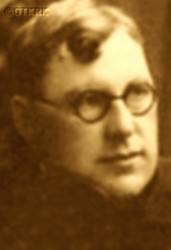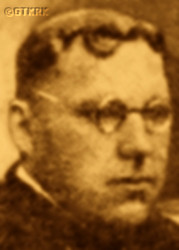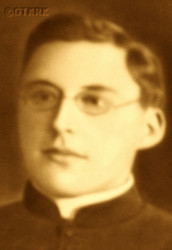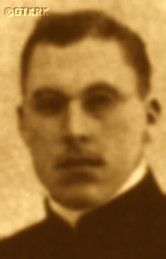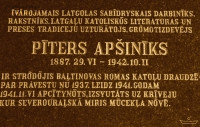Roman Catholic
St Sigismund parish
05-507 Słomczyn
85 Wiślana Str.
Konstancin deanery
Warsaw archdiocese, Poland
full list:
displayClick to display full list

searchClick to search full list by categories
wyświetlKliknij by wyświetlić pełną listę po polsku

szukajKliknij by przeszukać listę wg kategorii po polsku

Martyrology of the clergy — Poland
XX century (1914 – 1989)
personal data
religious status
Servant of God
surname
APSZYNAS
surname
versions/aliases
APSZYNIEKS, APSINIKS
forename(s)
Peter (pl. Piotr)
function
diocesan priest
creed
Latin (Roman Catholic) Church RCmore on
en.wikipedia.org
[access: 2014.09.21]
diocese / province
Riga archdiocesemore on
en.wikipedia.org
[access: 2013.05.19]
Mogilev archdiocesemore on
en.wikipedia.org
[access: 2013.06.23]
nationality
Latvian
date and place
of death
10.02.1942

ITL TavdinLagGuLAG slave labour camp network
today: Sverdlovsk oblast, Russia
details of death
After the start of the Russian occupation of Latvia (on 16.06.1940, Russia issued an ultimatum to Latvia, demanding an increase in the number of Russian troops in Latvia, and on 05.08.1940, Latvia was „incorporated” into Russia) — during World War II, which began with the German and Russian invasions of Poland in 09.1939 — arrested by the Russians on 13.06.1941 in his Baltinava parish village.
Accused of „agitation against the communist movement, condemnation of pioneer and communist organizations” and sentenced to slave labour in Russian concentration camps.
On 13.06.1941 deported to Russia.
Transported to ITL TavdinLag concentration camp where perished.
cause of death
extermination
perpetrators
Russians
sites and events
ITL TavdinLagClick to display the description, GulagClick to display the description, Deportations to SiberiaClick to display the description, Ribbentrop‐MolotovClick to display the description, Pius XI's encyclicalsClick to display the description
date and place
of birth
29.06.1887

Apšeniekitoday: Bērzpils pog., Balvi mun., Latvia
more on
lv.wikipedia.org
[access: 2021.05.20]
alt. dates and places
of birth
Gaigalavatoday: Gaigalava pog., Rēzekne mun., Latvia
more on
lv.wikipedia.org
[access: 2021.05.20]
presbyter (holy orders)
ordination
1915

positions held
1937 – 1941
parish priest — Baltinavatoday: Baltinava mun., Latvia
more on
en.wikipedia.org
[access: 2021.05.20] ⋄ Annunciation to the Blessed Virgin Mary RC parish
1936 – 1937
parish priest — Līksnatoday: Līksna pog., Augšdaugava mun., Latvia
more on
en.wikipedia.org
[access: 2022.06.29] ⋄ Sacred Heart of Jesus RC parish
1930 – 1936
parish priest — Preiļitoday: Preiļi mun., Latvia
more on
en.wikipedia.org
[access: 2022.06.29] ⋄ Assumption of the Blessed Virgin Mary RC parish
1925 – 1930
parish priest — Pušatoday: Puša pog., Rēzekne mun., Latvia
more on
lv.wikipedia.org
[access: 2022.06.29] ⋄ Holy Trinity RC parish
1920 – 1925
parish priest — Viļakaform.: Marienhauz
today: Viļaka pog., Balvi mun., Latvia
more on
en.wikipedia.org
[access: 2022.02.15] ⋄ Sacred Heart of Jesus RC parish — also: publisher and editor of the monthly „Flag of Christ”
c. 1920
vicar — Rogovkaalso: Nautrēni
today: Nautrēni pog., Rēzekne mun., Latvia
more on
lv.wikipedia.org
[access: 2021.12.18] ⋄ Immaculate Conception of the Blessed Virgin Mary RC parish
c. 1919
vicar — Sarkaņitoday: Lendži pog., Rēzekne mun., Latvia
more on
lv.wikipedia.org
[access: 2022.06.29] ⋄ Immaculate Conception of the Blessed Virgin Mary RC parish
c. 1918
vicar — Bērzgaletoday: Bērzgale pog., Rēzekne mun., Latvia
more on
lv.wikipedia.org
[access: 2022.06.29] ⋄ St Anne RC parish
1915 – 1918
vicar — Sankt Petersburgtoday: Saint Petersburg city, Russia
more on
en.wikipedia.org
[access: 2020.07.31] ⋄ St Catherine of Alexandria the Virgin and Martyr RC parish ⋄ Sankt Petersburgtoday: Saint Petersburg city, Russia
more on
en.wikipedia.org
[access: 2020.07.31] RC deanery — also: the chaplain of Latvian refugees during World War I, editor of the Latgalian press, publisher of „Strautiņš” magazine
chaplain — Mogilevtoday: Mogilev dist., Mogilev reg., Belarus
more on
en.wikipedia.org
[access: 2022.01.06] ⋄ military school
c. 1915
vicar — Preiļitoday: Preiļi mun., Latvia
more on
en.wikipedia.org
[access: 2022.06.29] ⋄ Assumption of the Blessed Virgin Mary RC parish
c. 1911 – 1915
student — Sankt Petersburgtoday: Saint Petersburg city, Russia
more on
en.wikipedia.org
[access: 2020.07.31] ⋄ philosophy and theology, Metropolitan Theological Seminary
writer, editor and author of many religious journals, works, articles and books
others related
in death
PUDANSClick to display biography Joseph
sites and events
descriptions
ITL TavdinLag: Russian Rus. Исправи́тельно‐Трудово́й Ла́герь (Eng. Corrective Labor Camp) ITL Rus. Тавдинский (Eng. Tavdinskiy) — concentration and slave forced labor camp (within the Gulag complex) — headquartered in Tavda in Sverdlovsk Oblast, on the Trans‐Siberian Railway Line. Founded on 17.04.1941. Prisoners slaved at the construction of an industrial complex (manufacturing, among others, wooden materials, ethyl alcohol, generators for cars, yeast), as well as an artillery materials factory, at agriculture, etc. At its peak c. 12,000 prisoners were held there: e.g. 5,671 (01.07.1941); 4,253 (01.01.1942); 11,701 (01.04.1942); 4,901 (01.01.1943); 2,349 (01.01.1944); 3,272 (01.01.1945). Ceased to exist on 29.08.1945. . In 2002 in vicinity mass graves were discovered with victims in Polish military uniforms. (more on: old.memo.ruClick to attempt to display webpage
[access: 2024.04.08])
Gulag: The acronym Gulag comes from the Rus. Главное управление исправительно‐трудовых лагерей и колоний (Eng. Main Board of Correctional Labor Camps). The network of Russian concentration camps for slave labor was formally established by the decision of the highest Russian authorities on 27.06.1929. Control was taken over by the OGPU, the predecessor of the genocidal NKVD (from 1934) and the MGB (from 1946). Individual gulags (camps) were often established in remote, sparsely populated areas, where industrial or transport facilities important for the Russian state were built. They were modeled on the first „great construction of communism”, the White Sea‐Baltic Canal (1931‐1932), and Naftali Frenkel, of Jewish origin, is considered the creator of the system of using forced slave labor within the Gulag. He went down in history as the author of the principle „We have to squeeze everything out of the prisoner in the first three months — then nothing is there for us”. He was to be the creator, according to Alexander Solzhenitsyn, of the so‐called „Boiler system”, i.e. the dependence of food rations on working out a certain percentage of the norm. The term ZEK — prisoner — i.e. Rus. заключенный‐каналоармец (Eng. canal soldier) — was coined in the ITL BelBaltLag managed by him, and was adopted to mean a prisoner in Russian slave labor camps. Up to 12 mln prisoners were held in Gulag camps at one time, i.e. c. 5% of Russia's population. In his book „The Gulag Archipelago”, Solzhenitsyn estimated that c. 60 mln people were killed in the Gulag until 1956. Formally dissolved on 20.01.1960. (more on: en.wikipedia.orgClick to attempt to display webpage
[access: 2024.04.08])
Deportations to Siberia: In 1939‐1941 Russians deported — in four large groups in: 10.02.1940, 13‐14.04.1940, 05‐07.1940, 05‐06.1941 — up to 1 mln of Polish citizens from Russian occupied Poland to Siberia leaving them without any support at the place of exile. Thousands of them perished or never returned. The deportations east, deep into Russia, to Siberia resumed after 1944 when Russians took over Poland. (more on: en.wikipedia.orgClick to attempt to display webpage
[access: 2014.09.21])
Ribbentrop‐Molotov: Genocidal Russian‐German alliance pact between Russian leader Joseph Stalin and German leader Adolf Hitler signed on 23.08.1939 in Moscow by respective foreign ministers, Mr. Vyacheslav Molotov for Russia and Joachim von Ribbentrop for Germany. The pact sanctioned and was the direct cause of joint Russian and German invasion of Poland and the outbreak of the World War II in 09.1939. In a political sense, the pact was an attempt to restore the status quo ante before 1914, with one exception, namely the „commercial” exchange of the so‐called „Kingdom of Poland”, which in 1914 was part of the Russian Empire, fore Eastern Galicia (today's western Ukraine), in 1914 belonging to the Austro‐Hungarian Empire. Galicia, including Lviv, was to be taken over by the Russians, the „Kingdom of Poland” — under the name of the General Governorate — Germany. The resultant „war was one of the greatest calamities and dramas of humanity in history, for two atheistic and anti‐Christian ideologies — national and international socialism — rejected God and His fifth Decalogue commandment: Thou shall not kill!” (Abp Stanislav Gądecki, 01.09.2019). The decisions taken — backed up by the betrayal of the formal allies of Poland, France and Germany, which on 12.09.1939, at a joint conference in Abbeville, decided not to provide aid to attacked Poland and not to take military action against Germany (a clear breach of treaty obligations with Poland) — were on 28.09.1939 slightly altered and made more precise when a treaty on „German‐Russian boundaries and friendship” was agreed by the same murderous signatories. One of its findings was establishment of spheres of influence in Central and Eastern Europe and in consequence IV partition of Poland. In one of its secret annexes agreed, that: „the Signatories will not tolerate on its respective territories any Polish propaganda that affects the territory of the other Side. On their respective territories they will suppress all such propaganda and inform each other of the measures taken to accomplish it”. The agreements resulted in a series of meeting between two genocidal organization representing both sides — German Gestapo and Russian NKVD when coordination of efforts to exterminate Polish intelligentsia and Polish leading classes (in Germany called «Intelligenzaktion», in Russia took the form of Katyń massacres) where discussed. Resulted in deaths of hundreds of thousands of Polish intelligentsia, including thousands of priests presented here, and tens of millions of ordinary people,. The results of this Russian‐German pact lasted till 1989 and are still in evidence even today. (more on: en.wikipedia.orgClick to attempt to display webpage
[access: 2015.09.30])
Pius XI's encyclicals: Facing the creation of two totalitarian systems in Europe, which seemed to compete with each other, though there were more similarities than contradictions between them, Pope Pius XI issued in 03.1937 (within 5 days) two encyclicals. In the „Mit brennender Sorge” (Eng. „With Burning Concern”) published on 14.03.1938, condemned the national socialism prevailing in Germany. The Pope wrote: „Whoever, following the old Germanic‐pre‐Christian beliefs, puts various impersonal fate in the place of a personal God, denies the wisdom of God and Providence […], whoever exalts earthly values: race or nation, or state, or state system, representatives of state power or other fundamental values of human society, […] and makes them the highest standard of all values, including religious ones, and idolizes them, this one […] is far from true faith in God and from a worldview corresponding to such faith”. On 19.03.1937, published „Divini Redemptoris” (Eng. „Divine Redeemer”), in which criticized Russian communism, dialectical materialism and the class struggle theory. The Pope wrote: „Communism deprives man of freedom, and therefore the spiritual basis of all life norms. It deprives the human person of all his dignity and any moral support with which he could resist the onslaught of blind passions […] This is the new gospel that Bolshevik and godless communism preaches as a message of salvation and redemption of humanity”… Pius XI demanded that the established human law be subjected to the natural law of God , recommended the implementation of the ideal of a Christian state and society, and called on Catholics to resist. Two years later, National Socialist Germany and Communist Russia came together and started World War II. (more on: www.vatican.vaClick to attempt to display webpage
[access: 2023.05.28], www.vatican.vaClick to attempt to display webpage
[access: 2023.05.28])
sources
personal:
biographies.library.nd.eduClick to attempt to display webpage
[access: 2014.12.20], www.preilubiblioteka.lvClick to attempt to display webpage
[access: 2016.03.14], www.balvurcb.lvClick to attempt to display webpage
[access: 2016.03.14]
bibliographical:
„Fate of the Catholic clergy in USSR 1917‐1939. Martyrology”, Roman Dzwonkowski, SAC, ed. Science Society KUL, 2003, Lublin
original images:
www.preilubiblioteka.lvClick to attempt to display webpage
[access: 2016.03.14], newsaints.faithweb.comClick to attempt to display webpage
[access: 2021.12.19], www.balvurcb.lvClick to attempt to display webpage
[access: 2016.03.14], www.balvurcb.lvClick to attempt to display webpage
[access: 2016.03.14], www.balvurcb.lvClick to attempt to display webpage
[access: 2016.03.14], ipn.gov.plClick to attempt to display webpage
[access: 2019.02.02]
LETTER to CUSTODIAN/ADMINISTRATOR
If you have an Email client on your communicator/computer — such as Mozilla Thunderbird, Windows Mail or Microsoft Outlook, described at WikipediaPatrz:
en.wikipedia.org, among others — try the link below, please:
LETTER to CUSTODIAN/ADMINISTRATORClick and try to call your own Email client
If however you do not run such a client or the above link is not active please send an email to the Custodian/Administrator using your account — in your customary email/correspondence engine — at the following address:

giving the following as the subject:
MARTYROLOGY: APSZYNAS Peter
To return to the biography press below:
 Click to return to biography
Click to return to biography








